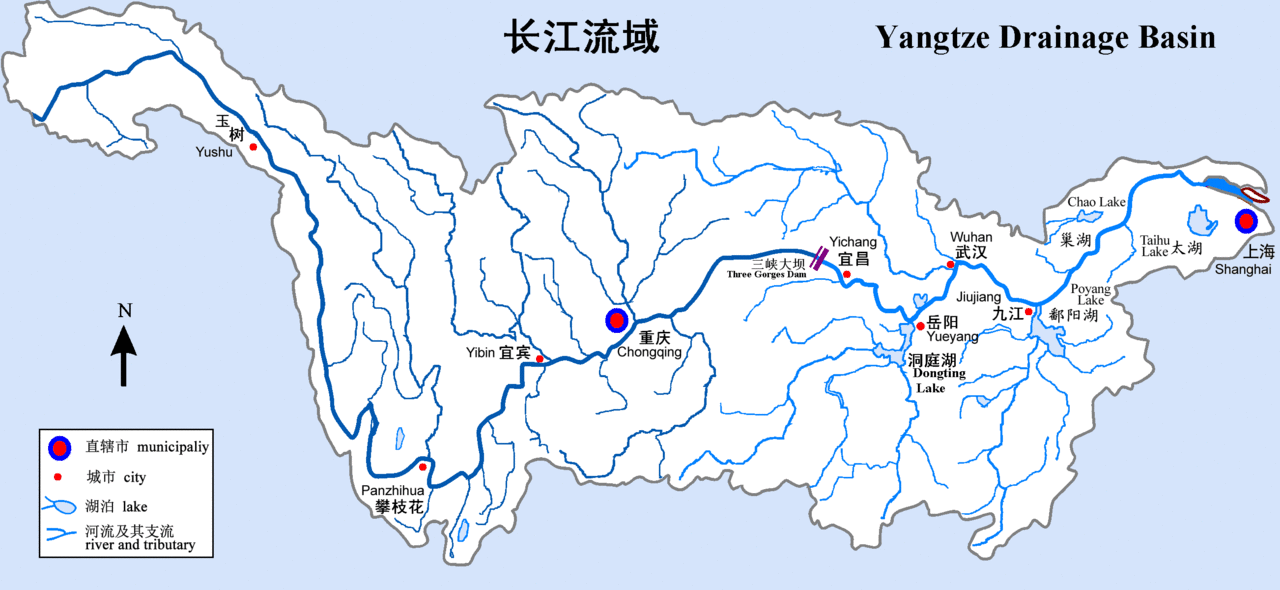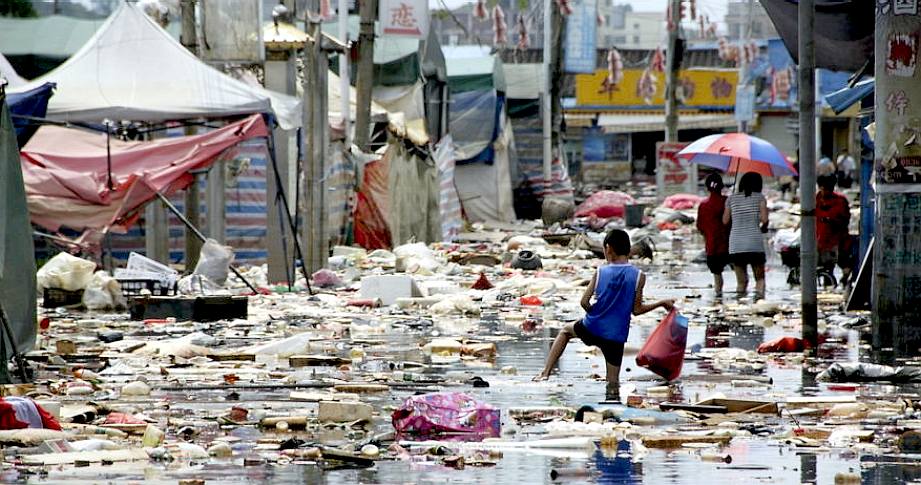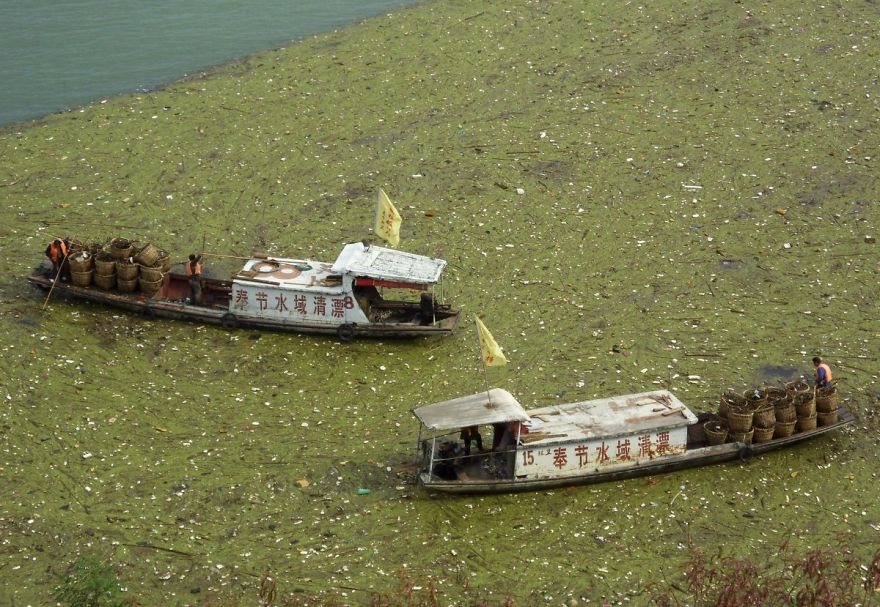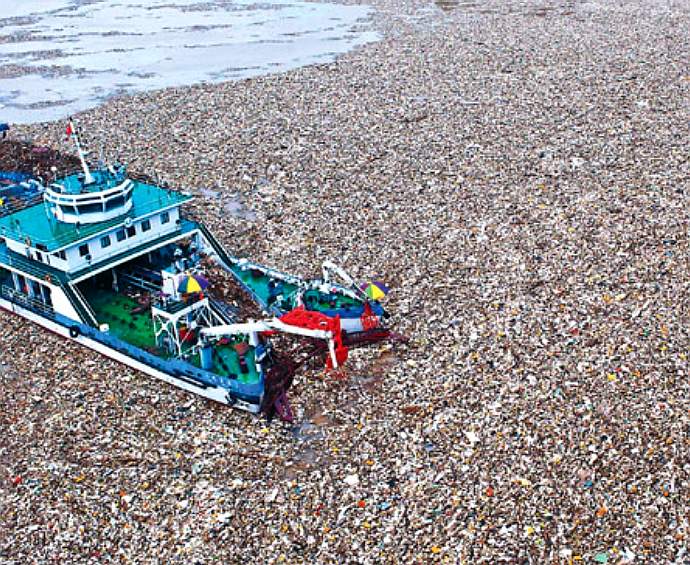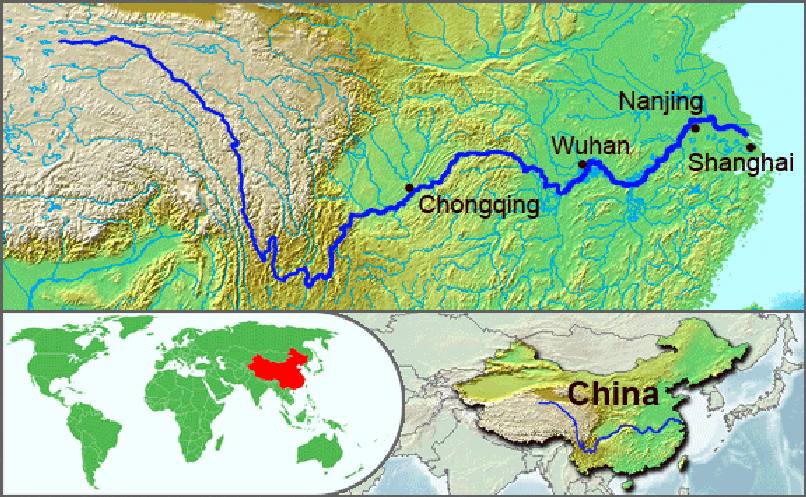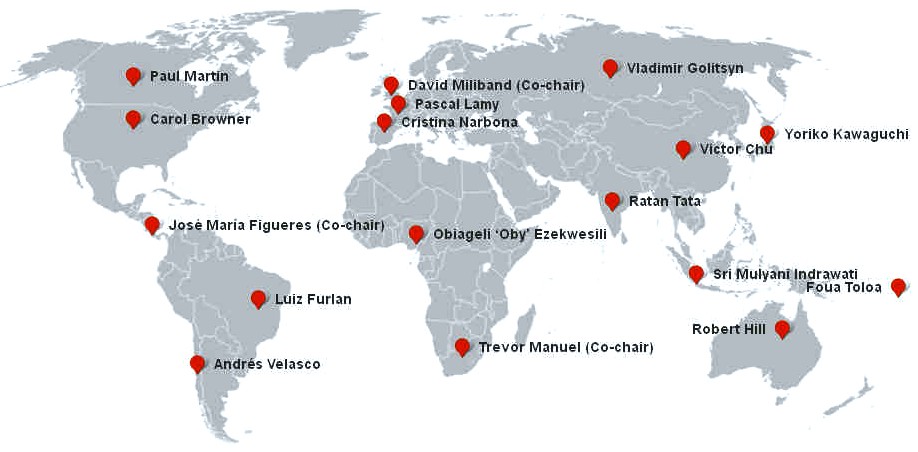|
THE YANGTZE
LONGEST ASIAN RIVER
|
|||||||||||||||||||||||||||||||||||||||||||||||||||||||||||||||||||||||||||||||||||||||||||||||||||||||||||||||||||||||||||||||
|
GEOGRAPHY - The Yangtze River, Chinese (Pinyin) Chang Jiang or (Wade-Giles romanization) Ch’ang Chiang , longest river in both China and Asia and the third longest river in the world, with a length of 3,915 miles (6,300 kilometres). Its basin, extending for some 2,000 miles (3,200 km) from west to east and for more than 600 miles (1,000 km) from north to south, drains an area of 698,265 square miles (1,808,500 square km). From its source on the Plateau of Tibet to its mouth on the East China Sea, the river traverses or serves as the border between 10 provinces or regions. More than three-fourths of the river’s course runs through mountains. The Yangtze has eight principal tributaries. On its left bank, from source to mouth, these are the Yalung, Min, Jialing, and Han rivers; those on the right bank include the Wu, Yuan, Xiang, and Gan rivers.
The Yangtze River known in China as the Cháng Jiāng ("Long River") or the Yángzi Jiāng, is the longest river in Asia and the third-longest in the world. It flows for 6,300 kilometers (3,915 mi) from the glaciers on the Qinghai-Tibet Plateau in Qinghai eastward across southwest, central and eastern China before emptying into the East China Sea at Shanghai. The river is the longest in the world to flow entirely within one country. It drains one-fifth of the land area of the People's Republic of China (PRC) and its river basin is home to one-third of the country's population. The Yangtze is also one of the biggest rivers by discharge volume in the world.
The Yangtze River Delta generates as much as 20% of the PRC's GDP. The Yangtze River flows through a wide array of ecosystems and is itself habitat to several endemic and endangered species including the
Chinese alligator, the finless porpoise, the Chinese paddlefish, the (possibly extinct) Yangtze River
dolphin or baiji, and the Yangtze sturgeon. For thousands of years, the river has been used for water, irrigation, sanitation, transportation, industry, boundary-marking and war. The Three Gorges Dam on the Yangtze River is the largest hydro-electric power station in the world.
AGRICULTURE
The Yangtze River Basin is a big granary of China. The grain it produces covers a half of the whole nation, of which the rice accounts for 70% in the total. Other crops such as cotton, barley, wheat, maize and bean are also produced in the area. Besides, it is the most prosperous and densely populated area in the country. The important cities with a population of over one million such as Shanghai, Nanjing, Wuhan, Chongqing and Chengdu are located in the area. Same as the Yellow River, Yangtze River is also the cradle of Chinese civilization. It is endowed with long history and abundant cultural relics.
POLLUTION
Rivaling the impact of the Three Gorges Dam, this basin faces unprecedented pollution as a result of rapid, large-scale industrial and domestic development, and agricultural runoff. According to Chinese environmental activist Dai Qing, the Yangtze used to be so clear that you could see a pen sink to the bottom. Now it has become so dirty that it is not fit for drinking.
RIVER CLEANERS - Spend the summer collecting floating garbage on the Yangtze River, the longest river in Asia. Battling scorching sun and tolerating the stench from the rubbish, these people are indeed unsung heroes trying to improve the quality of the waterway. Garbage collectors are local fishermen wanting an extra income to support their families.
STATISTICS
Chinese name:
长江 (Cháng Jiāng)
THE GUARDIAN JUNE 2015
More than 400 people are missing after a Chinese passenger boat sank on the Yangtze river after being hit by what the captain described as a cyclone.
Eastern Star had been travelling from Nanjing, the capital of Jiangsu province, to the south-western city of Chongqing when the incident happened.
Most were aged between 50 and 80, and were
traveling with Shanghai agency Xiehe Travel. The tour agency’s offices remained closed on Tuesday, as relatives of the missing gathered outside.
THE GLOBAL OCEAN COMMISSIONERS - Your representative for the GOC is shown on this map of the world showing the location of the Commissioners. Victor Chu is the most appropriate contact for the Yangtze River. Be aware that the GOC is likely to be wound down in 2016, having recommended doing not that much really in terms of plastic. What then was the purpose of funding you might ask? It is surely irresponsible to know of a problem and not suggest ways to prevent the problem worsening.
ENDANGERED SPECIES - The polluted Yangtze River in China supports millions of people in poverty who are dependent on the river for all their washing, drinking and nutritional needs. Barely surviving is also the critically endangered Baiji River Dolphin and Finless Porpoise. Over-fishing using unsustainable methods such as dynamite has degraded the river and reduced fish stocks to the detriment of both wildlife and the people who fish the river system.
Dr. Xianfeng Zhang is determined to improve fishing practices and prevent the extinction of the dolphins by launching a targetted educational campaign to raise awareness of the plight of these two highly vulnerable cetacean species. The project focuses on an educational media campaign targeting 3,000 local Yangtze fishermen in the middle and lower reaches of the Yangtze. The campaign aims to highlight the impact that current activities are having on the river’s flagship inhabitants, and to demonstrate the need for sustainable management and development of the Yangtze’s freshwater ecosystem resources. A Professor of Zoology and Conservation Biology at the Institute of Hydrobiology, Chinese Academy of Sciences, Dr. Zhang is an expert of cetacean biology and has over 20 years experience of educational initiatives and community engagement.
ACIDIFICATION - ADRIATIC - ARCTIC - ATLANTIC - BALTIC - BAY BENGAL - BERING - CARIBBEAN - CORAL - EAST CHINA ENGLISH CH - GOC - GULF GUINEA - GULF MEXICO - INDIAN - IOC - IRC - MEDITERRANEAN - NORTH SEA - PACIFIC - PERSIAN GULF RED
SEA - SEA
JAPAN - STH
CHINA - PLASTIC
- PLANKTON - PLASTIC
OCEANS - SEA
LEVEL RISE - UNCLOS
- UNEP
- WOC
- WWF AMAZON - BURIGANGA - CITARUM - CONGO - CUYAHOGA - GANGES - IRTYSH - JORDAN - LENA - MANTANZA-RIACHUELO MARILAO
- MEKONG - MISSISSIPPI - NIGER - RIVER
NILE
- PARANA - PASIG - SARNO - THAMES -
YANGTZE - YAMUNA - YELLOW
LINKS & REFERENCE
Travel China Guide river yangtze China Daily Sunday July 2012 22 Panda freshwater_decline 10_rivers_risk yangtze_threats The Guardian 2015 June China ship carrying 400 passengers sinks in Yangtze river Whitley Award Yangtze fishermen education baiji river dolphin finless porpoise China http://whitleyaward.org/winners/yangtze-fishermen-education-baiji-river-dolphin-finless-porpoise-china/ http://wwf.panda.org/about_our_earth/about_freshwater/freshwater_problems/river_decline/10_rivers_risk/yangtze/yangtze_threats/ http://www.theguardian.com/world/2015/jun/01/china-ship-carrying-400-passengers-sinks-in-yangtze-river http://www.britannica.com/place/Yangtze-River http://www.travelchinaguide.com/river/yangtze/ https://en.wikipedia.org/wiki/Yangtze http://www.chinadaily.com.cn/sunday/2012-07/22/content_15605882.htm
|
|||||||||||||||||||||||||||||||||||||||||||||||||||||||||||||||||||||||||||||||||||||||||||||||||||||||||||||||||||||||||||||||
|
This
website is Copyright © 2024 Bluebird Marine Systems Limited.
The names Bluebird™, Bluefish™,
Miss
Ocean™, RiverVax™,
SeaNet™,
SeaVax™
and the blue bird in flight
|
